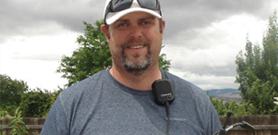
July 15, 2014
Flash communication device aims to help wildland firefighters
Prescott, AZ – Military technologies often make their way into the civilian world, but the recent transition of one high-tech system was spurred by the deaths of 19 “hotshot” firefighters in Arizona a year ago.
Realizing poor communication was a key factor in the June 30, 2013 Yarnell Hill Blaze that killed 19 Prescott, Ariz. firefighters, a federal defense agency vowed to deliver better communication capabilities to Prescott within a year after the tragedy. Beating that deadline, communications technology company Persistent Systems LLC, in late May delivered to the Prescott Fire Department communications equipment featuring what it calls its “revolutionary” Wave Relay technology.
The technology, so exclusive it was previously used by U.S. Special Operations Forces, allows uninterrupted communications to “hop” seamlessly between multiple users’ radios, effectively turning each user — whether on the ground or in the air — into a “self-forming” cell phone tower.
It also includes a feature that can run through a commercially available Android phone that allows everyone to see where all team members and support elements are, and to communicate in real time.
The specialized equipment was purchased by the Defense Advanced Research Projects Agency (DARPA) and donated to Prescott.
A local tie to the project is The Dalles resident Ben Wring, the senior sales engineer for Persistent Systems, which is based in New York City but has several remote workers, including Wring. “It’s cool to transition to civil use something we have used for years with the military,” said Wring. “This program enables fire line communications and real-time situational awareness in ways not previously available to these brave firefighters.”
The program is called FLASH, or Fire Line Advanced Situational Awareness for Handhelds.
A press release from Persistent Systems said the FLASH program “aims to end the day when firefighters are left to wonder where the fire line is, where their teammates are, or what the latest wind and weather reports are.”
Wring took the technology down to Arizona in May and trained the Prescott firefighters on it.
Wesley Mitchell, an account manager at Persistent Systems, said, “FLASH takes a battle-proven system and repurposes it for firefighters, giving them some of the same capabilities as we provide for the Department of Defense.”
FLASH permits each firefighter to know where every firefighter is, and where every plane is overhead. “Wave Relay transmits information seamlessly among and between all deployed assets,” said Mitchell.
The Wave Relay technology is especially apt for wildland firefighting because, like U.S. Special operations Forces teams, they often find themselves in austere landscapes, without cell phone reception or radio signal repeater towers.
“It really is a privilege for us to work with these firefighters,” Mitchell said. “We’re helping them to do their jobs more effectively and also more safely.”
If an agency doesn’t have a plane in the air to relay communications among assets, fire crews can quickly set up one of Persistent System’s Wave Relay ridge top relays, Wring said. The firefighters even become relays themselves as teams move around on site.
In addition to radios, the system’s handheld display feature, which operates on Android phones, allows a firefighter to chart a fire line that can be uploaded in real time and instantly observed by incident commanders and fellow firefighters.
“They can bread-crumb a trail as they walk,” Wring said.
“They can put a mark on the map where they want to coordinate a water drop and everyone can see it,” he added.
The Android phone is packaged in a military-grade, waterproof protective case which provides a rugged USB interface.
Persistent System’s Wave Relay technology converts the USB interface to Ethernet, Wring said. Wave Relay is a wireless ad hoc network, and the handheld radios and phones effectively become a wireless Ethernet cable. “It doesn’t need a host-client architecture to make everything work,” Wring said.
When a firefighter is mapping a fire line, for example, they take a geo-cached image on their Android phone with time/date/location information automatically included and broadcast it to everyone on the network.
“You see where everyone was walking and you see where they stopped to take a picture. You can see the fire develop and move,” Wring said.
“We’ve been kind of getting an education on how to fight wildfires,” Wring said. They learned it can take all day, sometimes, to get back to incident command on the boundaries of a wildfire, and of course, by then the boundaries will have changed.
With the Wave Relay technology, the command center can be a long distance away. For the May training exercise, the incident command was actually in Arlington, Va., headquarters of the federal defense agency which donated the equipment to the Prescott Fire Department.
Impressive as the technology is, it’s easy to use.
“Really, the firefighters only have to turn it on,” Wring said. “Many tell me they call it their ‘easy button’.”
